
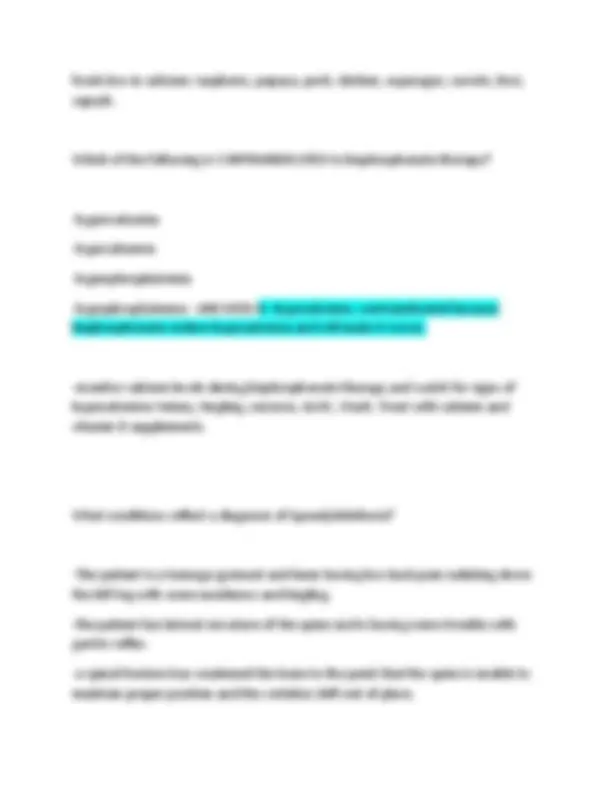
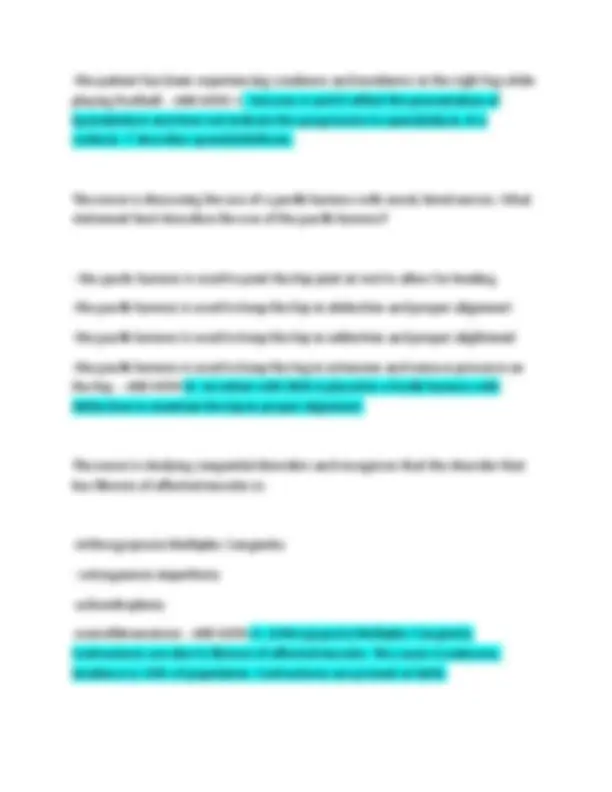
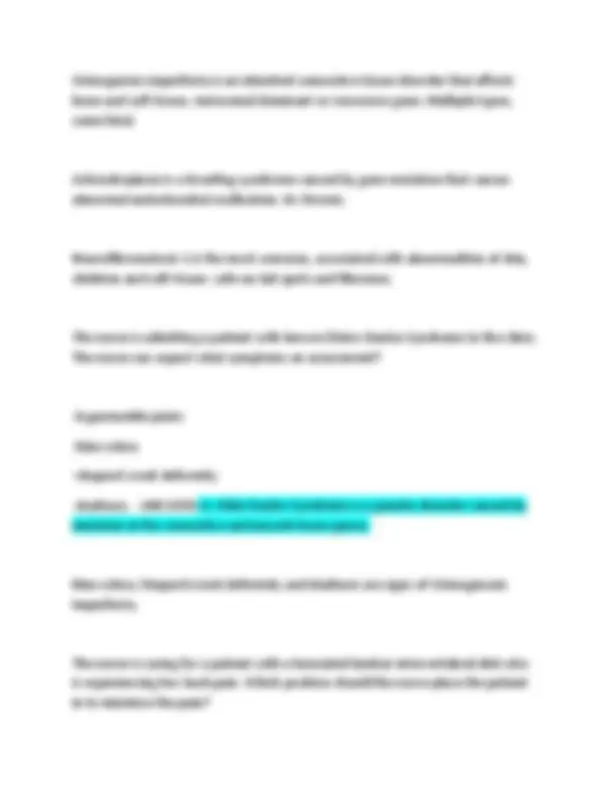
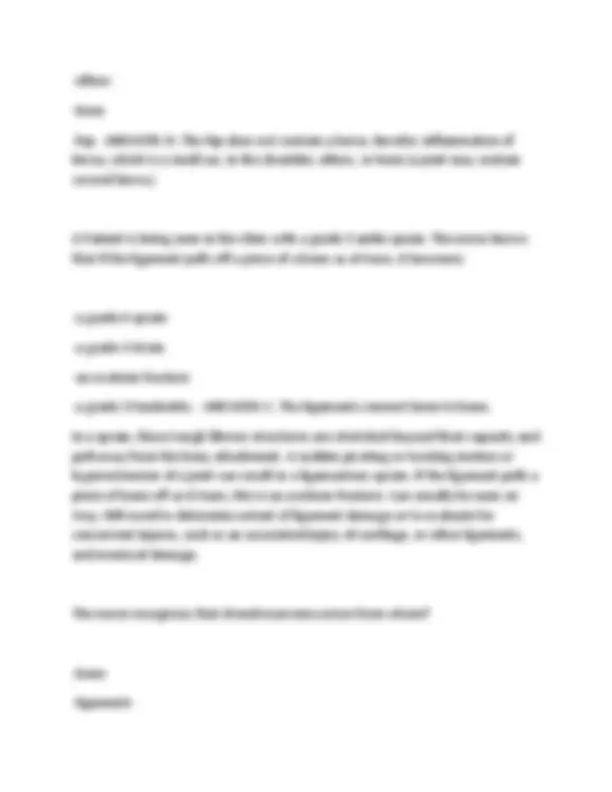
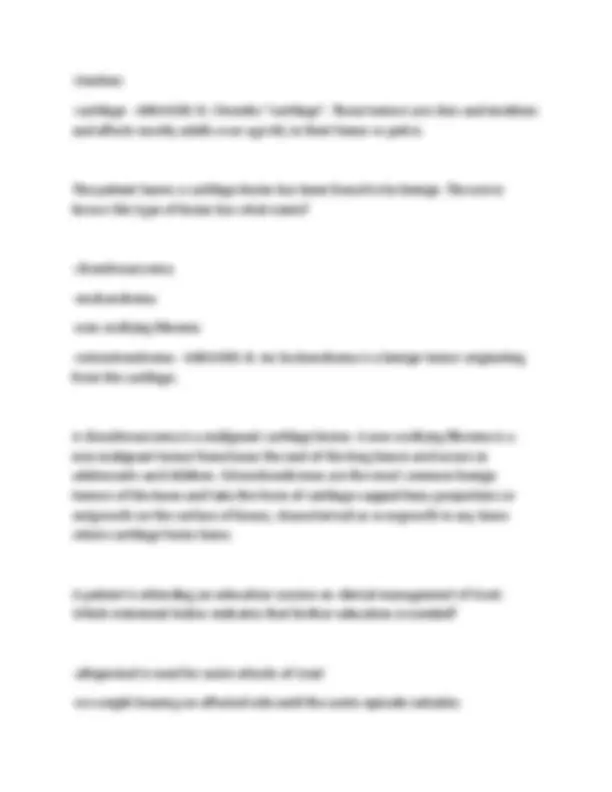
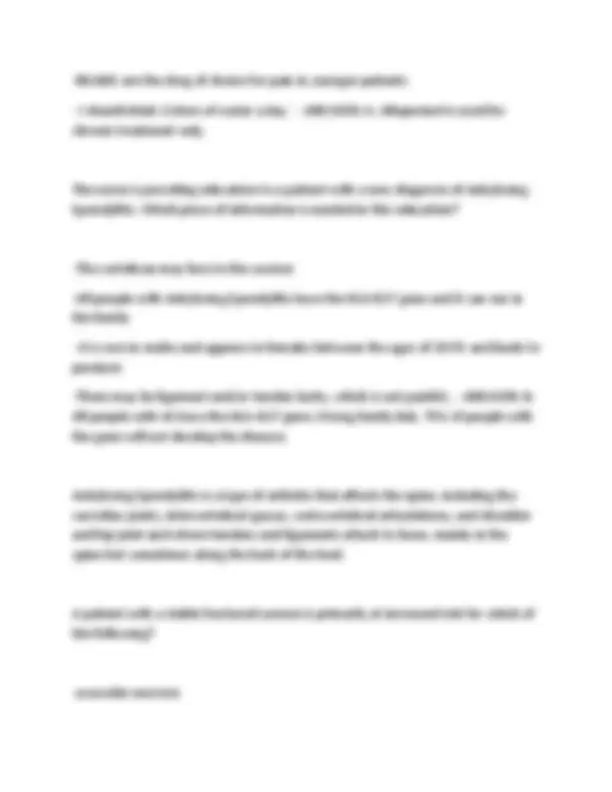
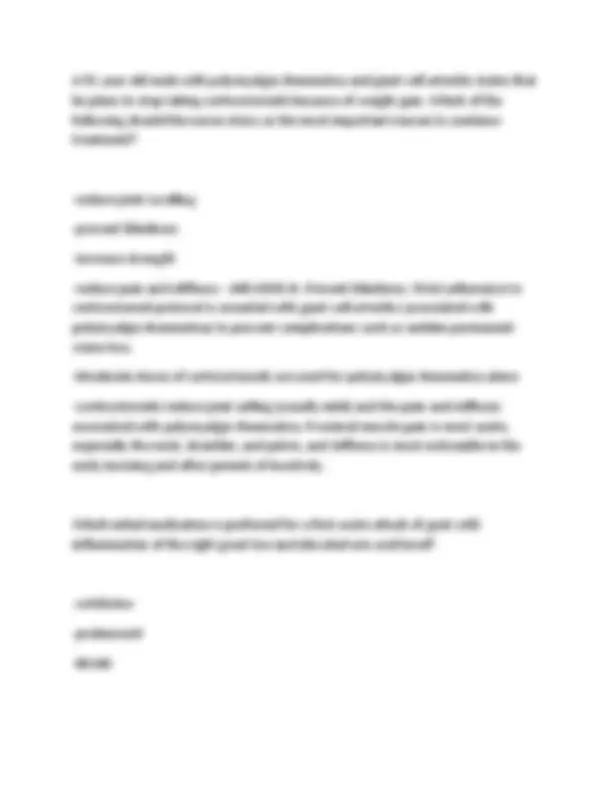
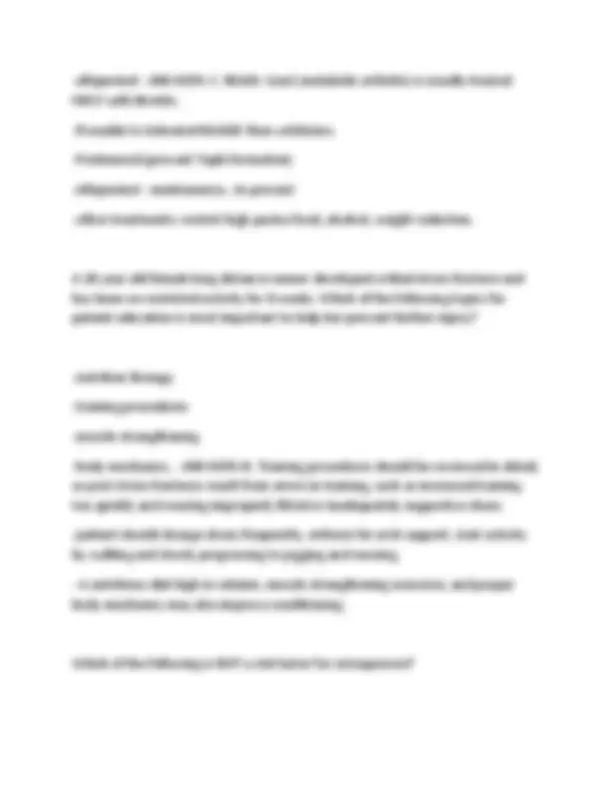
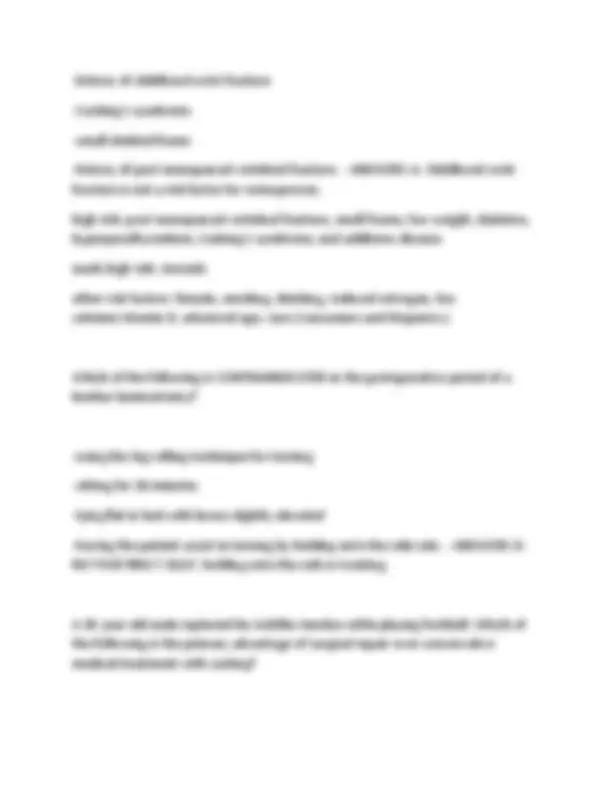
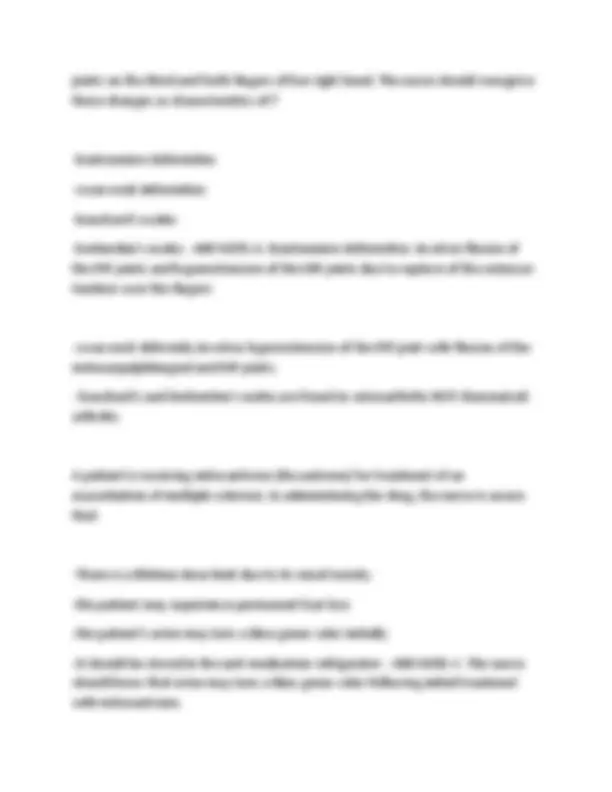
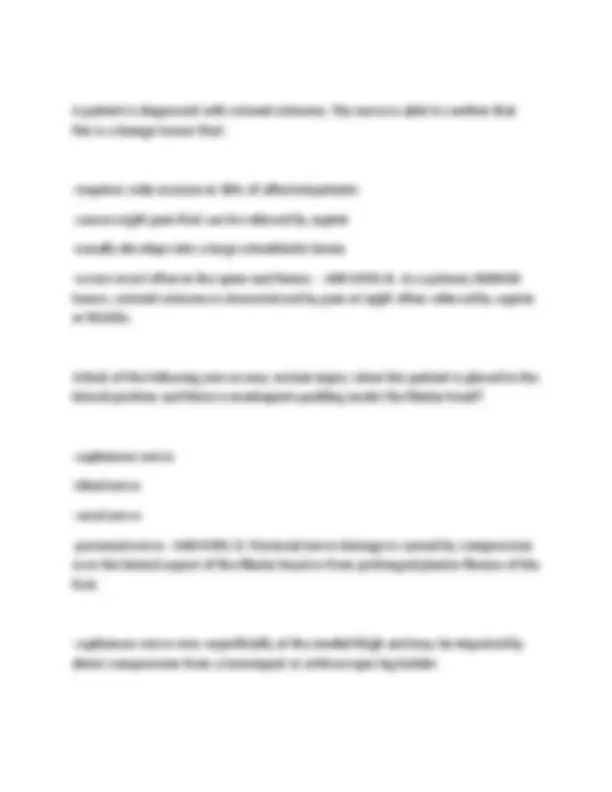
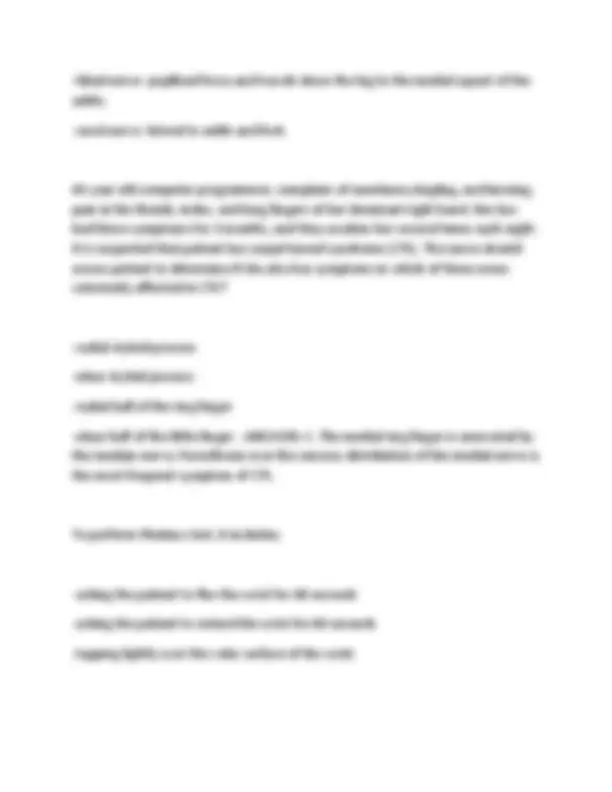
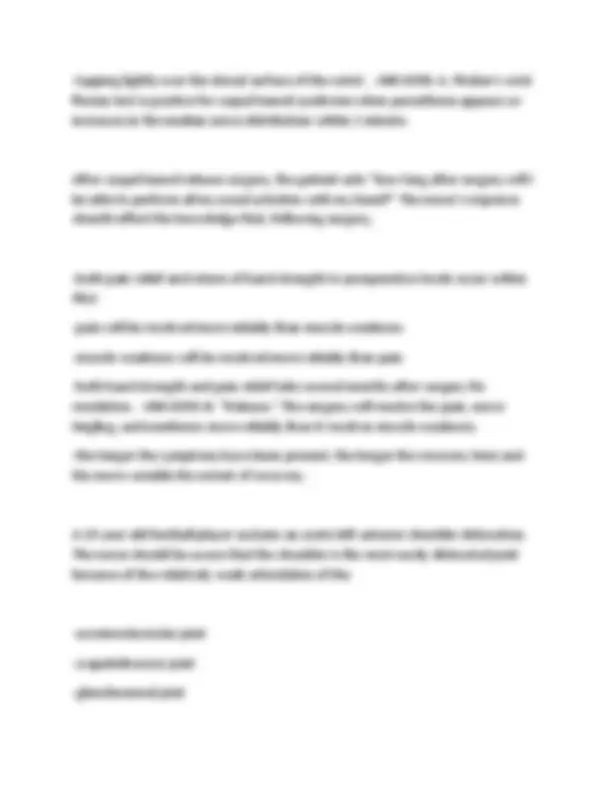
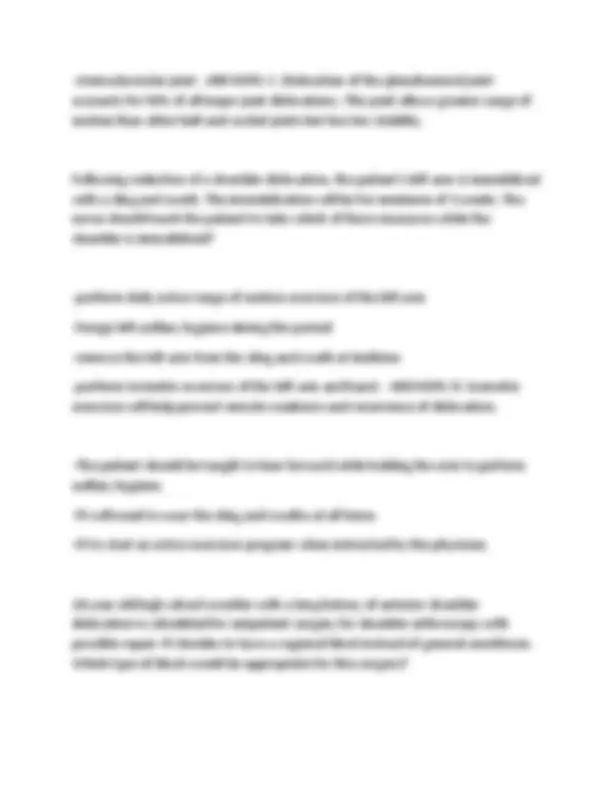
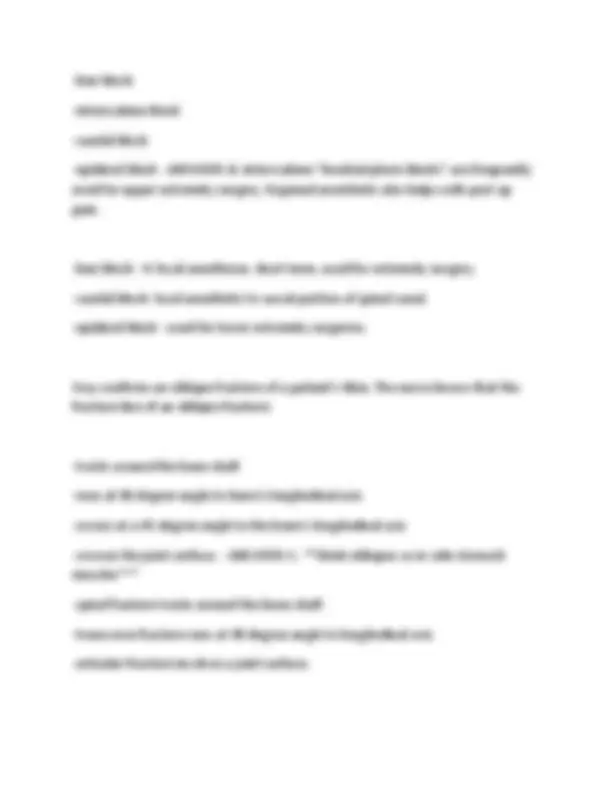
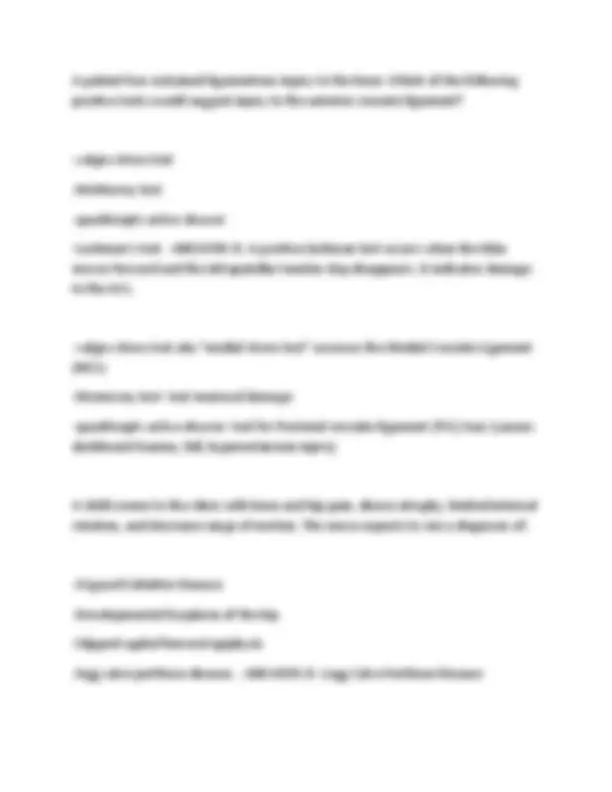
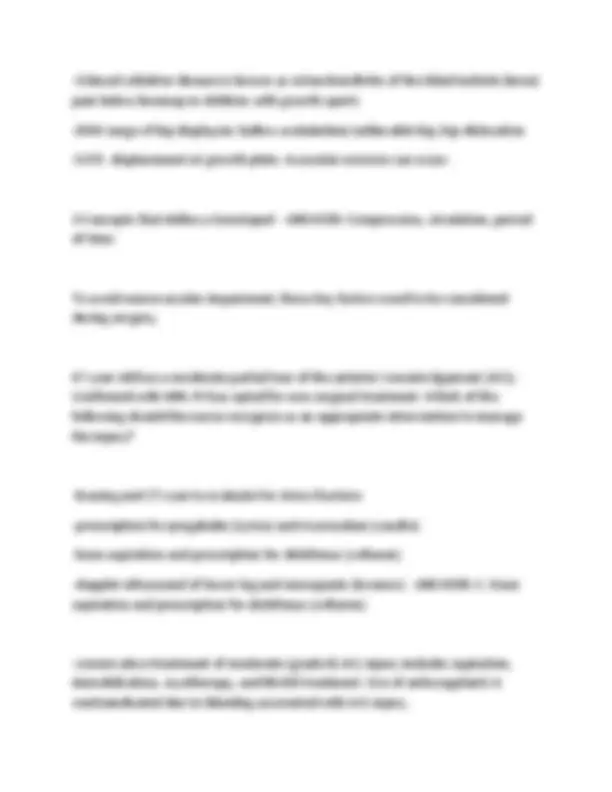
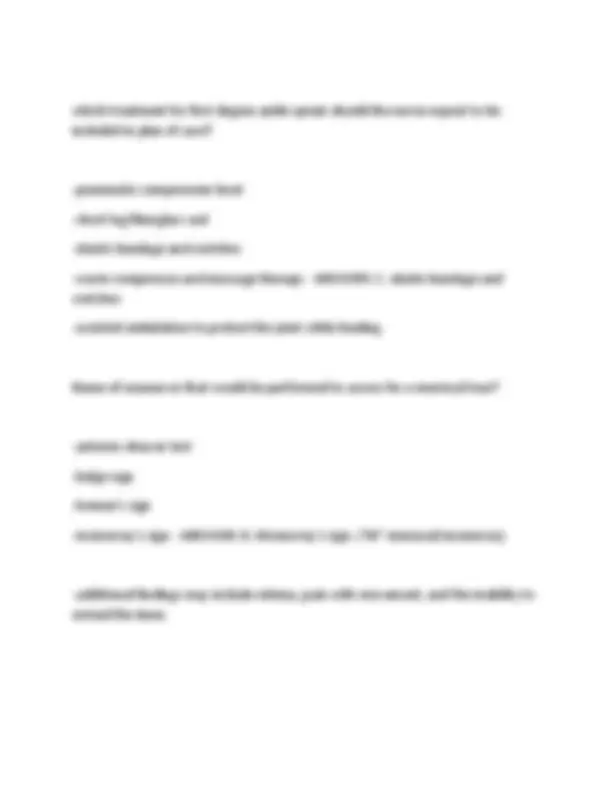
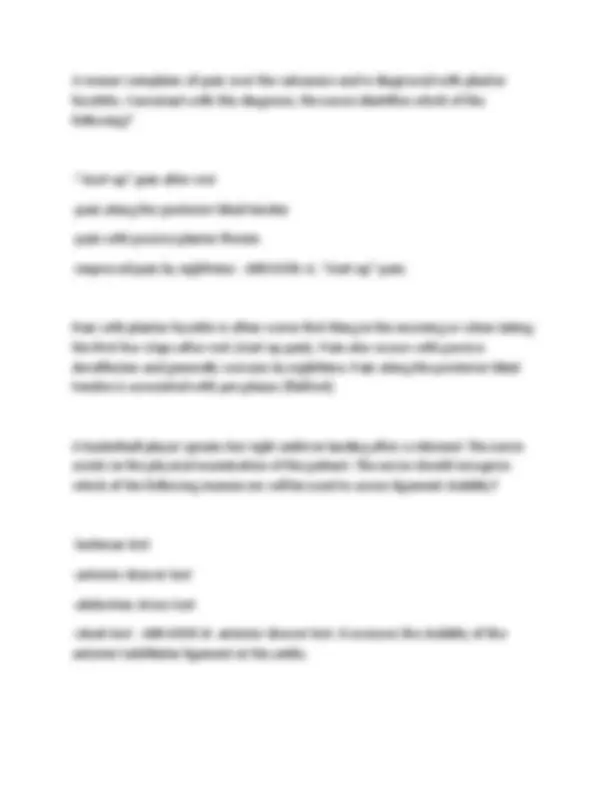
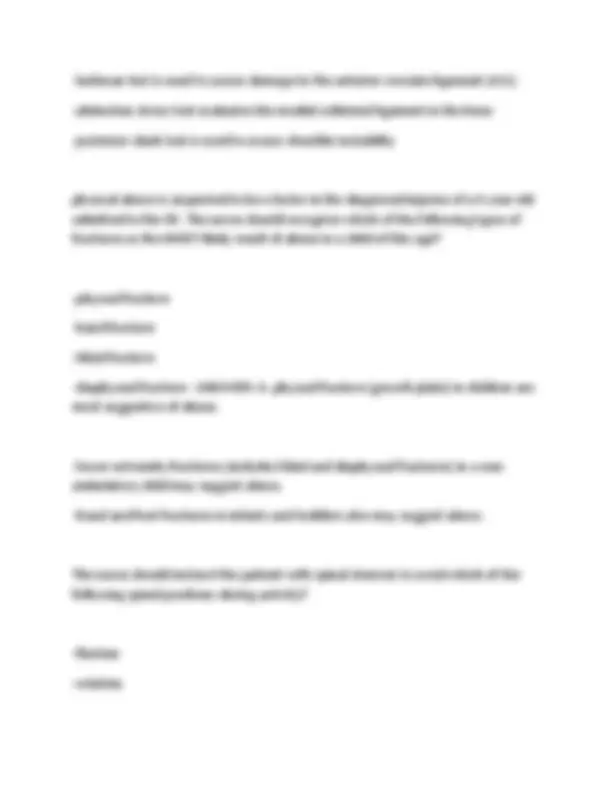

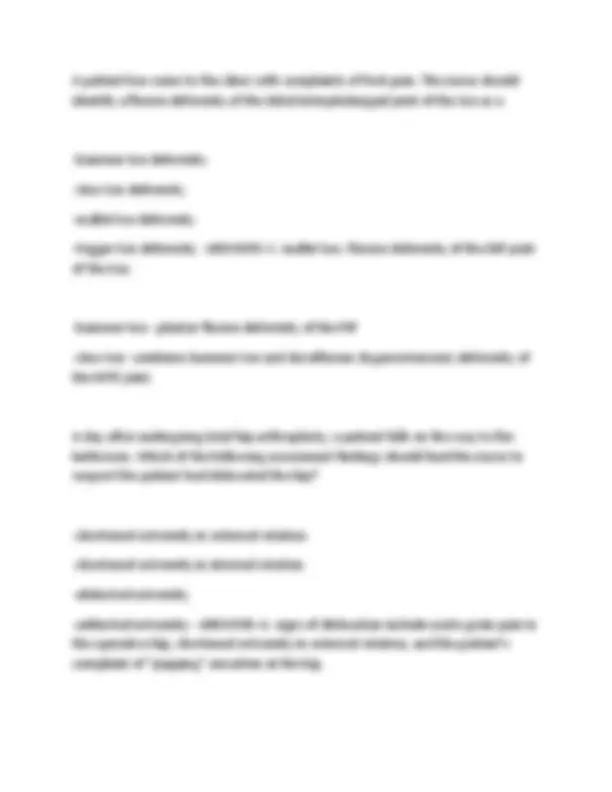
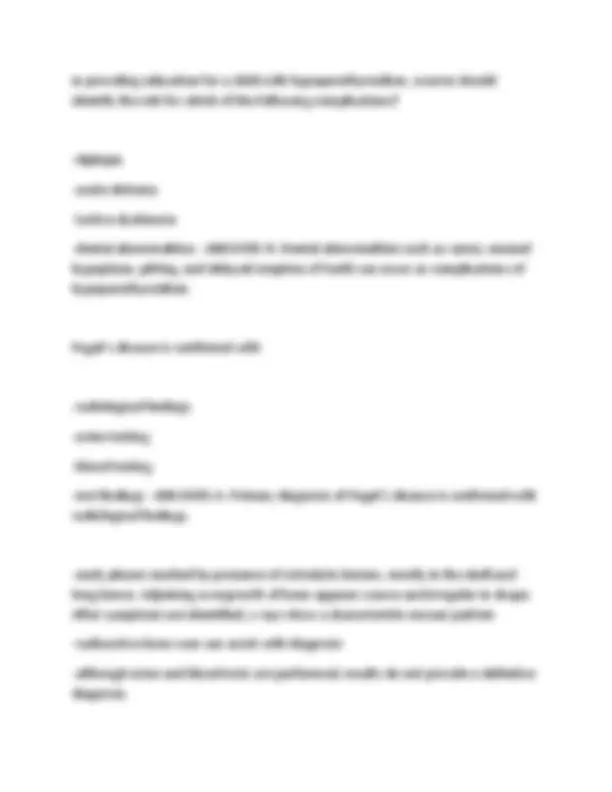
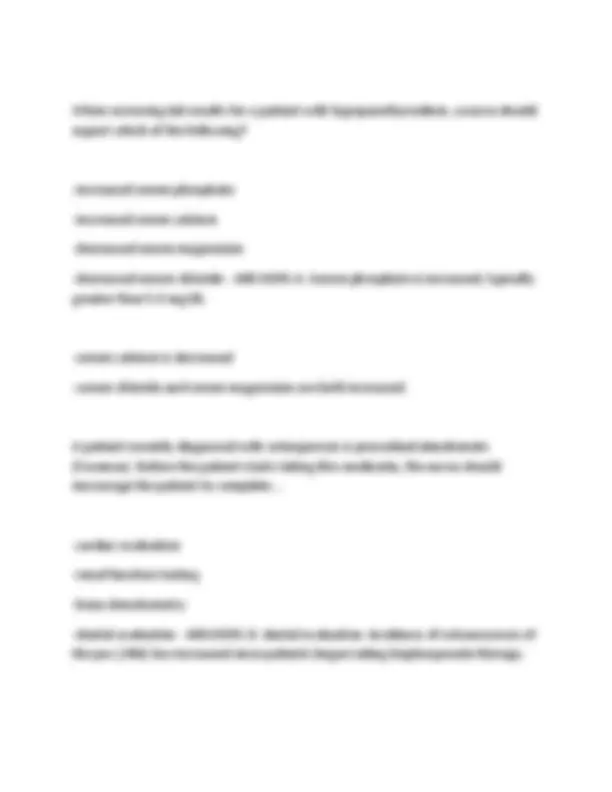
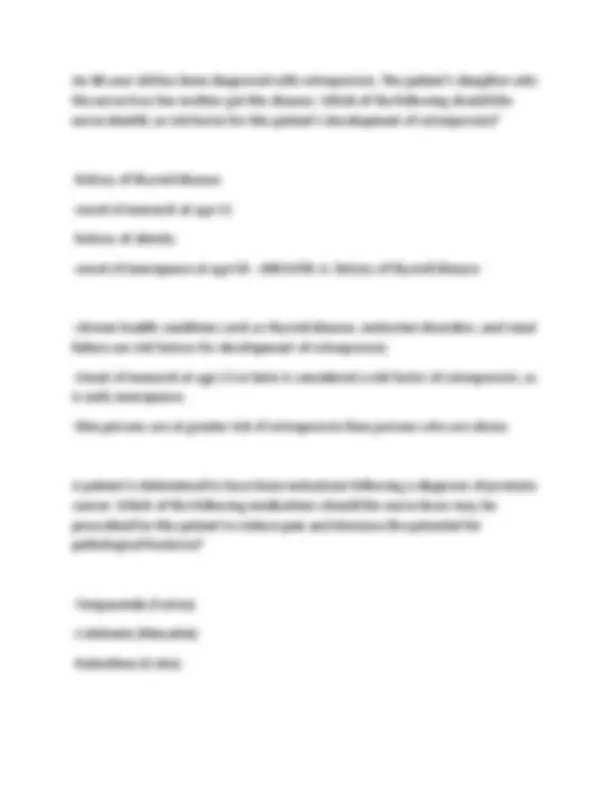
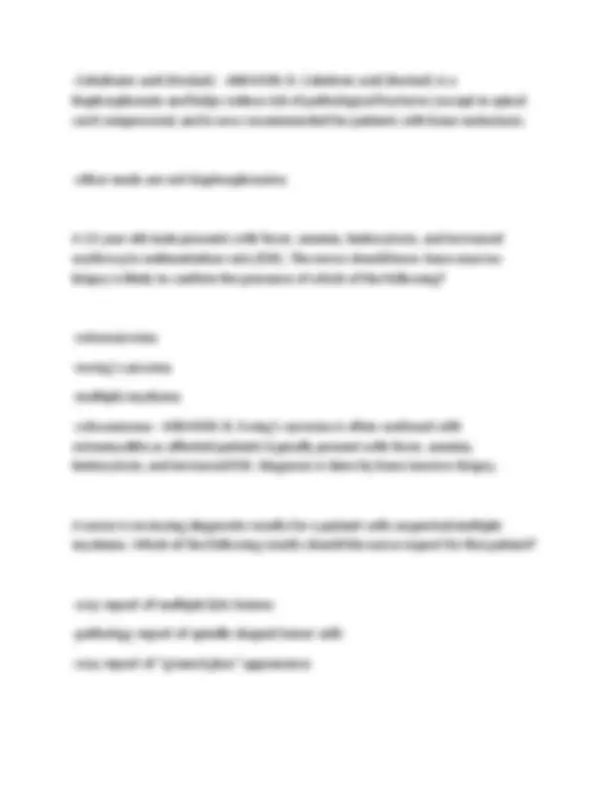
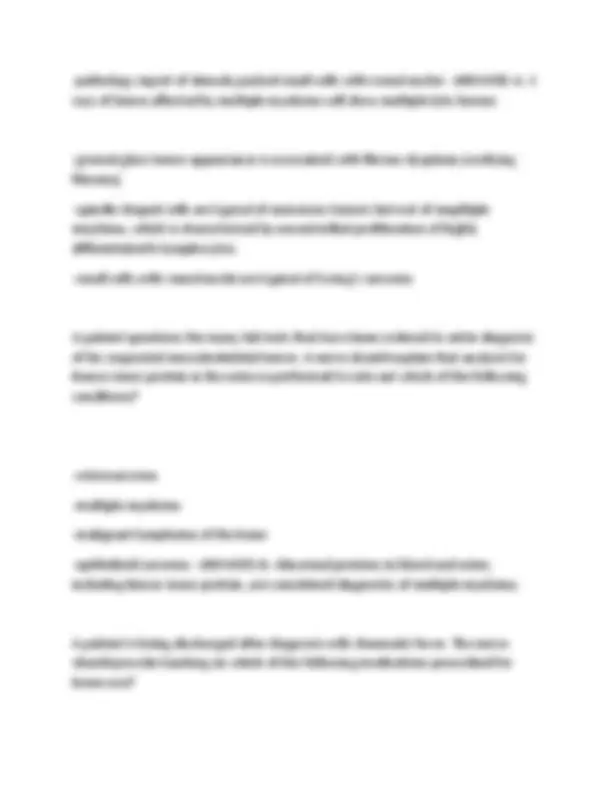
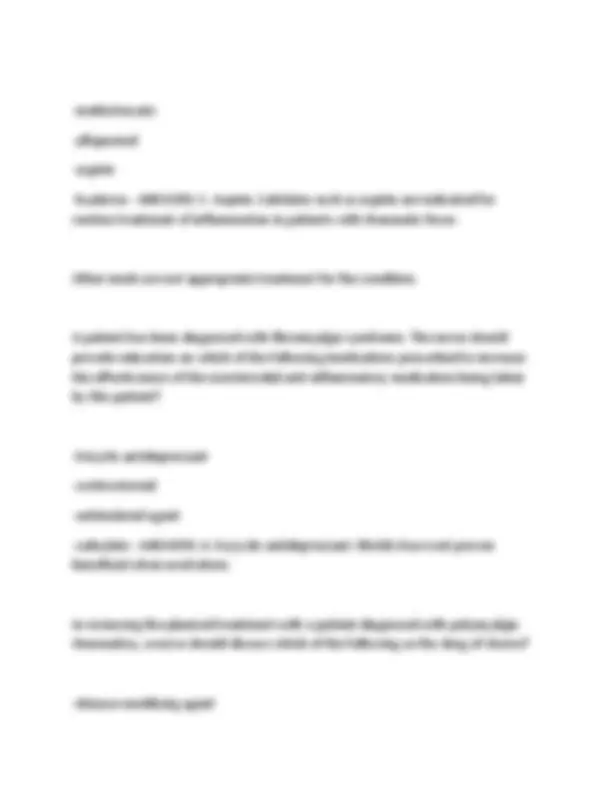
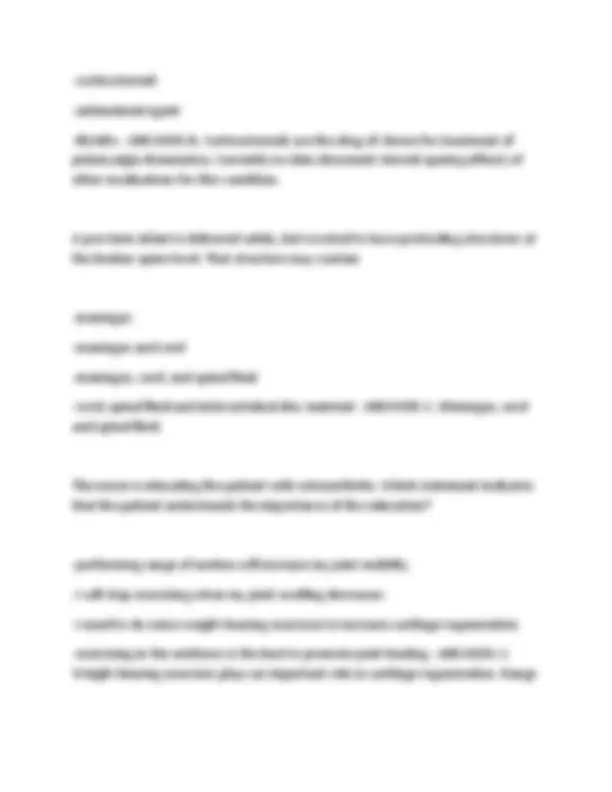



Study with the several resources on Docsity

Earn points by helping other students or get them with a premium plan


Prepare for your exams
Study with the several resources on Docsity

Earn points to download
Earn points by helping other students or get them with a premium plan
Community
Ask the community for help and clear up your study doubts
Discover the best universities in your country according to Docsity users
Free resources
Download our free guides on studying techniques, anxiety management strategies, and thesis advice from Docsity tutors
A series of multiple choice questions and answers covering various medical terms and concepts. It provides a valuable resource for students and professionals seeking to enhance their understanding of medical terminology and clinical scenarios. The questions cover topics such as systemic sclerosis, hyperparathyroidism, bisphosphonate therapy, spondylolisthesis, congenital disorders, herniated lumbar intervertebral disk, total hip arthroplasty, bursitis, ankle sprains, chondrosarcoma, gout, and ankylosing spondylitis.
Typology: Exams
1 / 38

This page cannot be seen from the preview
Don't miss anything!































A patient with the diagnosis of Systemic Sclerosis is complain of difficulty with mobility due to the skin becoming thick and tight. The nurse knows this condition is:
-Calcinosis
-sclerodactyly
-telangiectasia
-raynaud's phenomenon. - ANSWERS-B. Systemic Sclerosis (CREST)
C - calcinosis of skin--> calcium deposits under the skin leading to thickening.
R- Raynaud's
E - Esophageal dysfunction
S - sclerodactyly - tightening of the skin.
T- telangieciasis- dilated blood vessels.
A patient comes to the clinic. The nurse suspects hyperparathyroidism with which of the following signs and symptoms?
-Confusion, diarrhea, visual disturbances, hypermobility
-fatigue, random rash, abdominal pain, ulcers, joint pain
-renal stones, joint join and fractures, constipation
-muscular atrophy, memory decline, shortness of breath, constipation. - ANSWERS-C. STONES AND BONES are the most common findings (bone disease - weak bones, and renal stone disease/nephrolithiasis) - these are accepted as universal to hyperparathyroidism. Symptoms are not necessarily correlated with serum calcium level, but more commonly to how rapidly the serum calcium rises.
The patient is asking what foods contain high levels of calcium. What choices would be the most appropriate for the nurse's response?
-yogurt, sardines, spinach, broccoli, eggs
-cheese, asparagus, bread, carrots, kiwi
-milk, chicken, eggs, pork, squash
-yogurt, eggs, spinach, carrots, squash. - ANSWERS-A. Foods high in calcium: dairy products, white beans, spinach, broccoli, eggs, sardines, and kelp.
-the patient has been experiencing weakness and numbness in the right leg while playing football. - ANSWERS-C. Answers A and D reflect the presentation of Spondylolysis and does not indicate the progression to spondylolysis. B is scoliosis. C describes spondylolisthesis.
The nurse is discussing the use of a pavlik harness with newly hired nurses. What statement best describes the use of the pavlik harness?
-the pavlik harness is used to keep the hip in abduction and proper alignment
-the pavlik harness is used to keep the hip in adduction and proper alightment
-the pavlik harness is used to keep the leg in extension and remove pressure on the hip. - ANSWERS-B. An infant with DDH is placed in a Pavlik harness with ABDuction to maintain the hip in proper alignment.
The nurse is studying congenital disorders and recognizes that the disorder that has fibrosis of affected muscles is:
-Arthrogyrprosis Multiplex Congenita
-achondroplasia
-neurofibromatosis - ANSWERS-A. Arthrogryposis Multiplex Congenita. Contractures are due to fibrosis of affected muscles. The cause is unknown. Incidence is .03% of population. Contractures are present at birth.
Osteogenisis imperfecta is an inherited connective tissue disorder that affects bone and soft tissue. Autosomal dominant or ressessive gene. Multiple types, some fatal.
Achondroplasia is a dwarfing syndrome caused by gene mutation that causes abnormal endochondral ossification. its Chronic.
Neurofibromatosis 1 is the most common, associated with abnormalities of skin, skeleton and soft tissue. cafe-au-lait spots and fibromas.
The nurse is admitting a patient with known Ehlers-Danlos Syndrome to the clinic. The nurse can expect what symptoms on assessment?
-hypermobile joints
-blue sclera
-sheperd crook deformity
-deafness. - ANSWERS-A. Ehler Danlos Syndrome is a genetic disorder caused by mutation in the connective and muscle tissue genes.
Blue sclera, Shepard crook deformity and deafness are signs of Osteogenesis Imperfecta.
The nurse is caring for a patient with a herniated lumbar intervertebral disk who is experiencing low back pain. Which position should the nurse place the patient in to minimize the pain?
A.. Keep activity at a minimum so opiod intake is minimized
B. Because of the minimally invasive approach, no anticoagulants are necessary.
C. The use of an elevated toilet seat and shower chair.
D. Avoid turning knees or toes inward. - ANSWERS-D. mobilization is important for recovery. DVT prevention is needed. Anterior approach patient should AVOID turning knees or toes outward.
The patient has received a regional nerve block with their total knee replacement. What education should the nurse provide the patient to maintain patient safety?
-we will have oral pain medication available for breakthrough pain.
The nurse is caring for a patient with bursitis. The nurse knows that which joint does not contain a bursa:
-shoulder
-elbow
-knee
-hip - ANSWERS-D. The hip does not contain a bursa. Bursitis: inflammation of bursa, which is a small sac, in the shoulder, elbow, or knee (a joint may contain several bursa.)
A Patient is being seen in the clinic with a grade 3 ankle sprain. The nurse knows that if the ligament pulls off a piece of a bone as at tears, it becomes:
-a grade 4 sprain
-a grade 3 strain
-an avulsion fracture
-a grade 3 tendonitis. - ANSWERS-C. The ligaments connect bone to bone.
In a sprain, these tough fibrous structures are stretched beyond their capacity and pull away from the bony attachment. A sudden pivoting or twisting motion or hyperextension of a joint can result in a ligamentous sprain. If the ligament pulls a piece of bone off as it tears, this is an avulsion fracture. Can usually be seen on Xray. MRI used to determine extent of ligament damage or to evaluate for concurrent injures, such as an associated injury of cartilage, or other ligaments, and meniscal damage.
The nurse recognizes that chondrosarcoma arises from where?
-bone
-ligaments
-NSAIDS are the drug of choice for pain in younger patients
The nurse is providing education to a patient with a new diagnosis of Ankylosing Spondylitis. Which piece of information is needed in this education?
-The vertebrae may fuse to the sacrum
-All people with Ankylosing Spondylitis have the HLA-B27 gene and it can run in the family
-There may be ligament and/or tendon laxity, which is not painful., - ANSWERS-B. All people with AS have the HLA-B27 gene. Strong family link, 75% of people with the gene will not develop the disease.
Ankylosing Spondylitis is a type of arthritis that affects the spine, including the sacroiliac joints, intervertebral spaces, costovertebral articulations, and shoulder and hip joint and where tendons and ligaments attach to bone, mainly in the spine but sometimes along the back of the heel.
A patient with a stable fractured sacrum is primarily at increased risk for which of the following?
-avascular necrosis
-fat embolizm
-paralytic ileus
-DVT - ANSWERS-C. Stable fractured SACRUM has risk for ileus, monitor bowel sounds. A stable pelvic structure usually heals rapidly because the blood supply is good;
-however PELVIC fractures have increased risk of fat embolism, DVT.
-Avascular necrosis may occur with any bone if blood supply is disrupted.
A 58 year old patient with Lambert-Eaton myasthenic syndrom (LEMS) has the highest risk for which of the following?
-respiratory failure
-cancer
-blindness
-weight gain - ANSWERS-C. Blindness. LEMS is commonly paraneoplastic (80% of patents develop cancer) Vision impairment relates to diplopia and ptosis.
-respiratory depression is rarely severe
-weight loss is common.
A 55 year old male had palmar and digital fasciectomies to correct the flexion deformity associated with Dupuytren's contracture. Which of the following topics for home care instruction is most critical?
A 55 year old male with polymyalgia rheumatica and giant cell arteritis states that he plans to stop taking corticosteroids because of weight gain. Which of the following should the nurse stress as the most important reason to continue treatment?
-reduce joint swelling
-prevent blindness
-increase strength
-reduce pain and stiffness - ANSWERS-B. Prevent blindness. Strict adherence to corticosteroid protocol is essential with giant cell arteritis (associated with polymyalgia rheumatica) to prevent complications such as sudden permanent vision loss.
-Moderate doses of corticosteroids are used for polymyalgia rheumatica alone
-corticosteroids reduce joint selling (usually mild) and the pain and stiffness associated with polymyalgia rheumatica. Proximal muscle pain is most acute, especially the neck, shoulder, and pelvis, and stiffness is most noticeable in the early morning and after periods of inactivity.
Which initial medication is preferred for a first acute attack of gout with inflammation of the right great toe and elevated uric acid level?
-colchicine
-probenecid
-NSAID
-allopurinol - ANSWERS-C. NSAID. Gout (metabolic arthritis) is usually treated FIRST with NSAIDs.
-If unable to tolerated NSAIDS then colchicine.
-Probenecid (prevent Tophi formation)
-Allopurinol - maintanence...to prevent
-other treatments: restrict high purine food, alcohol, weight reduction.
A 28 year old female long distance runner developed a tibial stress fracture and has been on restricted activity for 8 weeks. Which of the following topics for patient education is most important to help her prevent further injury?
-nutrition therapy
-training procedures
-muscle strengthening
-body mechanics, - ANSWERS-B. Training procedures should be reviewed in detail, as post stress fractures result from errors in training, such as increased training too quickly and wearing improperly fitted or inadequately supportive shoes.
-patient should change shoes frequently, orthosis for arch support, start activity by walking and slowly progressing to jogging and running.
Which of the following is NOT a risk factor for osteoporosis?
-lower rate of rerupture
-lower rate of infection
-less pain
-faster recovery period. - ANSWERS-A. The primary advantage of surgical repair of a rupture of the Achilles tendon over conservative medical treatment is lower rate of rerupture.
A 70 year old woman fell on an open dorsiflexed hand, resulting in a fracture of the distal radius. Two days after closed reduction and application of a short arm cast, the patient took a shower and got the proximal part of the cast damp. Which initial intervention is indicated?
-removal and reapplication of the cast
-drying the cast with hair drying on cool setting
-allowing the cast to air dry only
-replacing the cast with a splint. - ANSWERS-B. if cast is extensively damaged or remains wet, needs to be changed
Which of the following is NOT one of the 3 components of the female athlete triaid?
-eating disorder
-osteoporosis
-overuse syndrome
-amenorrhea - ANSWERS-C. Overuse syndrome, although it may occur, is not a component of the female athlete triad which is:
Ms. Turner has an acute episode of painful swelling of multiple joints accompanied by disabling morning stiffness. After undergoing a series of tests, she is diagnosed with rheumatoid arthritis. Ms. Turner's blood test results are likely to reveal elevated......
-red blood cell count
-erythrocyte sedimentation rate
-uric acid
-alkaline phosphatase - ANSWERS-B. Elevated erythrocyte sedimentation rate is typical for RA.
-A mild anemia usually found (not elevated rbc)
-other tests are not for RA
Ms. Turner has Rheumatoid arthritis. She develops flexion of the proximal interphalangeal (PIP) joints and hyperextension of the disal interphalangeal (DIP)
A patient is diagnosed with osteoid osteoma. The nurse is able to confirm that this is a benign tumor that:
-requires wide excision in 90% of affected patients
-causes night pain that can be relieved by aspirin
-usually develops into a large osteoblastic lesion
-occurs most often in the spine and femur. - ANSWERS-B. As a primary BENIGN tumor, osteoid osteoma is characterized by pain at night often relieved by aspirin or NSAIDs.
Which of the following nerves may sustain injury when the patient is placed in the lateral position and there is inadequate padding under the fibular head?
-saphenous nerve
-tibial nerve
-sural nerve
-peroneal nerve - ANSWERS-D. Peroneal nerve damage is caused by compression over the lateral aspect of the fibular head or from prolonged plantar flexion of the foot.
-saphenous nerve runs superficially at the medial thigh and may be impaired by direct compression from a tourniquet or arthroscopic leg holder.
-tibial nerve- popliteal fossa and travels down the leg to the medial aspect of the ankle.
-sural nerve- lateral to ankle and foot.
44 year old computer programmer, complains of numbness,tingling, and burning pain in the thumb, index, and long fingers of her dominant right hand. She has had these symptoms for 3 months, and they awaken her several times each night. It is suspected that patient has carpal tunnel syndrome (CTS). The nurse should assess patient to determine if she also has symptoms in which of these areas commonly affected in CTS?
-radial styloid process
-ulnar styloid process
-radial half of the ring finger
-ulnar half of the little finger - ANSWERS-C. The medial ring finger is enervated by the median nerve. Paresthesia over the sensory distribution of the medial nerve is the most frequent symptom of CTS.
To perform Phalen;s test, it includes;
-asking the patient to flex the wrist for 60 seconds
-asking the patient to extend the wrist for 60 seconds
-tapping lightly over the volar surface of the wrist.